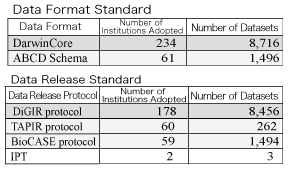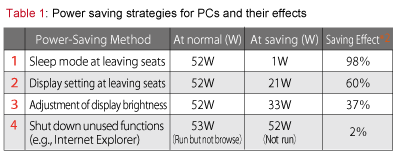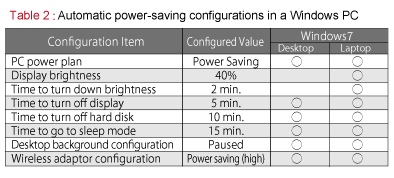|
 |
■ Bioresources information is available at the following URLs
|
 |
|
News from Information Center Global Biodiversity Information Facility (GBIF) moves forward to the 3rd Phase - I -
Hideaki Sugawara, Specially Appointted Professor, National Institute of Genetics
|
The Global Biodiversity Information Facility (GBIF) was established in 2001. Its goal is to establish a database infrastructure of worldwide biodiversity information that will be available to anyone at any time in any place. Since its inception, GBIF has received contributions from affiliated countries and benefitted from the independent efforts of international institutions and projects in the field of biodiversity (Sugawara, 2006※1)). In its first phase (2001–2006), GBIF made steady strides by adopting the motto, "Proving the Concept," and this progress has continued in the second phase (2007–2011), "Towards Full Operation." By the end of 2010, 55 countries and 46 international organizations and projects had participated in GBIF. One can batch-search and browse distribution information from 2.7 billion pieces of biodiversity information contained in 10,000 datasets provided by 300 data-providing institutions.
The 10th Conference of the Parties to the Convention on Biological Diversity (CBD COP10) was organized in Nagoya, Japan, in October 2010. One of the important achievements of this conference was the formulation of the Nagoya Protocol, which addresses the concepts of access and benefit sharing (ABS), i.e., unbiased sharing of benefits gained by using genetic resources (Suzuki, 2010–2011※2). Implementation of the ABS requires annotated data for each genetic resource, e.g., data about when and where the resource existed/exists and what type of resource it was/is, and also an information administration system using which one can trace back the originating country of a commercialized genetic resource.
Another important achievement of CBD COP10 was the adoption of “Aichi Targets.” The target laid out at the 6th Conference of the Parties to the Convention on Biological Diversity (CBD COP6) in 2002 was “to achieve a significant reduction of the current rate of biodiversity loss by 2010.” However, admittedly, this was not accomplished. Instead, 20 new specific targets to be achieved, the Aichi Targets, were adopted (Ministry of the Environment, 2010※3). One of the targets is as follows: "By 2020, knowledge, the science base and technologies relating to biodiversity, its values, functioning, status and trends, and the consequences of its loss, are improved, widely shared and transferred, and applied. (http://www.cbd.int/sp/targets/)" This indicates that the sharing of data reflecting the current biodiversity circumstances is included as a target to be achieved by 2020.
|
| |
References |
| |
※1 |
Hideaki Sugawara(2006)
"Global Biodiversity Information Facility (GBIF)— In 2011, GBIF will provide 1 billion data of biodiversity information on 1.8 million species" *Bioresource Now! Vol.2. No.2 |
| |
※2 |
"(2010-2011)
"Convention on Biological Diversity and the Circumstances Surrounding Genetic Resources" (three-part series)
*BioResource Now! Vol 6. No.12, Vol 7. No. 1, Vol 7. No.2 |
| |
※3 |
Ministry of the Environment(2010) “New Strategy Plans for Treaties (sections regarding the targets of post 2010) (tentative translation by the Ministry of the Environment)”
http://www.env.go.jp/press/file_view.php?serial=16471&hou_id=13104 (Japanese) |
|
It is universally acknowledged that GBIF provides the information infrastructure that is required to implement the Nagoya Protocol and the “Aichi Targets” adopted at COP10. GBIF chose the slogan, “Seizing the Future to Benefit Science and Society” for the third phase (2012–2016). Indeed, many international organizations and projects concerning biodiversity, ecology, and taxonomy (listed in Table 1) expected GBIF to be the provider of information infrastructure and enhanced their partnerships with GBIF. During its third phase, GBIF will also play a crucial role in the "United Nations Decade on Biodiversity 2011–2020".
Table 1
|
|
What does GBIF Japan National Node do ?
1)Release of domestic data to GBIF
Biodiversity information at GBIF is exhaustively searchable via a distributed integrated system. In other words, if the nodes of countries and international organizations follow the GBIF standards when releasing data that originated from their regions or are related to a particular field, the system at the GBIF headquarters in Copenhagen then conducts global indexing so that anyone can search and browse those data. Therefore, the first role of the GBIF Japan National Node is to release domestic data according to the standards of the GBIF. The GBIF Japan National Node consists of the National Institute of Genetics (NIG) and the University of Tokyo that have been cooperatively releasing mostly observational data and the National Museum of Nature and Science (NMNS) that has been releasing mostly sample data to GBIF.
As a result, as of May 2011, 2.35 million observational or sample data on animals, plants, and microorganisms were released. This number of released data accounts for only a small portion of the total data released to GBIF, which number about 270 million, but it ranks 15th among affiliated countries and the highest among Asian countries.
A tool should be prepared to release domestic data. NIG renewed a data-releasing protocol to the newest Integrated Publishing Toolkit (IPT: http://gbif.ddbj.nig.ac.jp/ipt/) in the fiscal year 2010. As a result, more diversified data items can be released, and institutions providing the data and their sources can be visualized, as shown in Fig. 1. NMNS consolidated dictionaries of natural geographical names in addition to tools for releasing data to GBIF, and the University of Tokyo prepared dictionaries of scientific names. |
 |
Fig. 1: Integrated Publishing of GBIF
Visualization of data source now conducted easily with a toolkit: Example of the data released by NIG visualized according to hosting body (data providers), region, and coordinates.
|
|
NIG adopted the IPT alternative to the Distributed Generic Information Retrieval (DiGIR) in 2010; however, many other data standards coexist in GBIF. The numbers of users and datasets are summarized in Table 2 (http://www.gbif.nig.ac.jp/stat/index.html (Japanese only)). The easy-to-use DarwinCore and DiGIR appear to be used frequently because the majority of the data originates from the United States.
NIG also recognized that Excel is frequently used for data administration at observation sites and research laboratories; therefore, they developed a macro-enabled Excel workbook in 2010 that can determine the compatibility of data using DarwinCore. This is an easy-to-use tool that can run on almost any PC and that is released from the data release support page of the GBIF Japan portal site (http://www.gbif.nig.ac.jp/gbif_regist.html (Japanese only)) for promoting the release of data to GBIF.
(to be continued)
 |
Table 2: Usage status of GBIF data release protocol
DarwinCore and DiGIR protocol are the standards developed by groups in the United States, and the Access to Biological Collections Data (ABCD) Schema, the TDWG Access Protocol for Information Retrieval (TAPIR) protocol, and the Biological Collection Access Service (BioCASE) protocol are those developed by the Taxonomic Database Working Group (TDWG; http://www.tdwg.org/). IPT is a toolkit that has been integrated in GBIF and that was released in 2010, and TAPIR can be selected as a data release protocol. |
|
"translated by ASL traslation service, and validited by the author"
|
|
Power-Saving Strategies in PCs
|

The maximum power supply level decreased because of the impact of the 2011 Tohoku Earthquake and Tsunami; thus, power shortage is of great concern. Due to the impossibility of storing electric power, power companies cannot supply more than the maximum power supply level. An effective strategy is thus to know the peak time of power consumption※1 and to reduce power use at least during that peak time. Accordingly, power-saving strategies for PCs are introduced in this issue so that each individual can take part in avoiding a massive power shortage in summer when power demand increases (Table 1).
※1 Power use status graph released by Tokyo Electric Power Company.
http://www.tepco.co.jp/en/forecast/html/index-e.html

※ 2 Data were evaluated using an integrated desktop 2010 model running Windows 7.
Reference URL:http://technet.microsoft.com/ja-jp/windows/gg715287 (Japanese only)
|
|
 Sleep mode at leaving seats. Sleep mode at leaving seats.
The sleep mode function is used to save work in memory and to allow the PC to stand-by in a power-saving mode. In addition, ongoing tasks can be resumed more quickly from the sleep mode than after turning the PC on from its powered-off condition. However, since the power consumption of a PC in sleep mode is slightly higher than in its powered-off condition, turning off the power is recommended at bedtime or when the PC will be unused for longer than half a day.
 Display setting at leaving seats. Display setting at leaving seats.
The sleep mode momentarily suspends operations on PCs, and thus, it cannot be used during file downloading or virus scanning. When you leave seats during these processes, turning off the display power will save electricity.
 Adjustment of display brightness. Adjustment of display brightness.
Decreasing the brightness of commonly used displays will save electricity.
Display brightness can be changed by pressing buttons on the display and adjusting the brightness from the menu. In the case of laptop computers, this is achieved by pressing the Fn key and one of the function keys simultaneously.
 Shut down unused functions. Shut down unused functions.
Speakers and external hard disk drives connected to PCs consume power even if they are in a stand-by condition. In addition, services activated in PCs increase both the load on the CPU and power consumption. Therefore, shutting down unused devices or functions as much as possible will save electricity.
(However, devices that require a long time to boot, such as PCs and printers, consume a lot of power during the boot process. Therefore, leaving the power on might actually result in less power being consumed overall, especially when the device is reused within approximately 2 h.
|
|

Program that configures power saving automatically
In addition, a program that automatically configures power-saving settings is distributed for Windows PCs, and the power-saving effect of this program is that the average power consumption is at a level of 70% of that with the initial configuration (Table 2).
URL: http://support.microsoft.com/kb/2545427/ja (Japanese only)

In this manner, small efforts can reduce power consumption to some degree. Each of us can do our part to conserve electricity in order to avoid a significant power shortage in our lives.
(Hiroki Watanabe, Center for Genetic Resource Information)
|
|
|